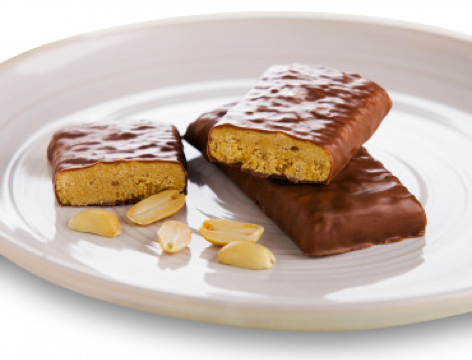Take the Stress Out of Stress Eating: 6 Tips

This article was written for WonderSlim by registered dietitians Sharon Howard R.D., M.S., C.D.E., L.D.N., F.A.D.A., owner of Nutrition for Living, and Lisa Diewald R.D.
You come in the door, frustrated with traffic, tired from work, drop your keys and head right for the refrigerator. Sound familiar? Not surprising. According to the American Psychological Association, 38% of adults report they engaged in “stress eating” in the past month. Of those, 49% report that they do this frequently-weekly or more often. Regular indulgences can wreak havoc on the body’s delicate energy balance system, resulting in weight gain - not to mention the shame, embarrassment and frustration that ensue following a night of stress-induced munching on carbs, sweets and high fat savory snacks.
Why does this happen? Why do we seek out food to calm, comfort and sustain us following a stressful day or week? A simple look at the body’s response to stress can shed some light.
Stress Hormone = Activated
Let’s say you are driving on the road and hit a patch of ice. Your car veers off course and careens, slow motion-like, into a guardrail. The airbags deploy and you find yourself safe, but very shaken up. Your heart is racing. You’re numb. For a period of time afterwards, you feel out-of-sorts. Episodes placing us in sudden peril cause the release of a hormone called cortisol, the stress hormone. Cortisol directs the body to respond as though it was being attacked. Blood flow is diverted to muscles and energy is made readily available to help “fight the enemy.”
The system works well in an emergency situation. After the emergency is over, cortisol levels gradually return to normal. However, when the body is under constant stress, cortisol production remains elevated. High cortisol levels increase cravings for quick energy foods that provide fuel for what the body mistakenly believes is true need. This is why most stress eaters report they seek out comfort foods rich in carbs such as chips, cookies, french fries and ice cream. Frequent consumption may lead to unwanted weight gain-right in the abdominal region-for easy mobilization in the event of “emergency” need. The trouble is, there is rarely an emergency need, so the weight gain remains as well.
This isn’t all bad news. You CAN control stress eating. The first step is to identify whether the knee-jerk reaction to eat you are experiencing is real hunger-or just the cortisol machine working overtime.
Real Hunger vs. Emotional Hunger
Real HungerEmotional (Stress) Hunger
GradualSuddenCan be satisfied with a variety of different foods (not picky)Craves specific foods, such as cookies, cake, french fries, chocolate. Not willing to settle for other foods.Based in the stomachBased in the head/mindHappens out of physical need - not emotional upsetAccompanied by upsetting emotions
Stops when fullOccurs due to desire to relax, to cover up painful feelings. Does not stop when full.Healthy relationship with food. Food nourishes. Everyone needs to eat.Associated with guilt or shame.
How to Control Stress Eating
- Ride the Crave Wave. Think of managing the stress eating habit as riding a wave. Like a wave, a craving builds to a peak, then subsides. The next time you crave a particular food, ride the wave. Tell yourself that the craving will lessen with time. Occupy yourself in an activity you enjoy while you ride out the storm.
- Take a bite break. Did a dozen bagels mysteriously appear in the break room? Tell yourself that just because the food is there, and it’s free, doesn’t mean you have to eat it. Create a physical distance between you and the food by leaving the room. Taking this break gives you the opportunity to evaluate whether you are truly hungry. If you are hungry, and these free foods appear on a regular basis, bring a small snack such as fruit, string cheese, 10 almonds or a tbsp of hummus or peanut butter as an easy to retrieve, lower calorie alternative to the office food..
- Before reaching for food at the end of a stressful day, identify the emotion causing the stress and acknowledge the feeling. Eating may not be the best way to gain comfort from anger, grief, disappointment, loneliness, fatigue or boredom. A brisk walk, yoga, meditation, reading, or talking may give you longer term comfort.
- Keep a food journal. Tracking intake will help you identify what triggers you to eat, while maintaining accountability. Easy to use fitness apps, such as Lose It! or MyFitness Pal, make this easy, quick and convenient if you prefer using your phone for tracking. If you don’t have time to keep a food journal, snap a picture of the food and return later to track it.
- Discover your own alternatives to eating. Make a list of “Necessary Activities” (laundry, bill paying, dishes, etc) and “Enjoyable Activities” (knitting, TV, crafts, reading, talking with a friend, etc). Place this list where you can easily see it. When the desire to stress-eat hits, consult the list and spend a few minutes doing one from each list prior to eating anything.
- Break the habit. It takes several weeks to break a long lasting habit, so don’t be discouraged if you try a few strategies and lapse into old habits. Be patient with yourself and try again, remembering that each time you practice a new habit is an opportunity for this new habit to replace the old one.
Stress-Busting Snacks

Next time you are ready to deep dive into the ice cream, try one of these healthier, stress-busting snacks instead:
- 1/2 cup low fat cottage cheese, 1/4 cup berries, 6 almonds, slivered
- 6 oz nonfat Greek yogurt plus 1/4 cup walnuts
- 1 hardboiled egg, 1 slice whole wheat toast
- 1 Wonderslim Shake or Wonderslim Bar
- 5 dark chocolate-covered almonds (use >70% cocoa)
- 1 cup minestrone or vegetable-packed soup
- 1 banana or apple with 1 tbsp peanut or almond butter
- 1/4 cup hummus with unlimited raw vegetables
- 1/4 cup unsweetened oatmeal or steel cut oats made with milk or almond milk plus 1/2 cup berries